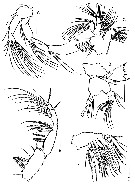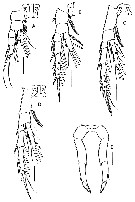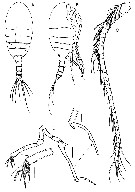|
|
 |
Fiche d'espèce de Copépode |
|
|
Calanoida ( Ordre ) |
|
|
|
Clausocalanoidea ( Superfamille ) |
|
|
|
Stephidae ( Famille ) |
|
|
|
Stephos ( Genre ) |
|
|
| |
Stephos geojinensis Moon, Youn & Venmathi Maran, 2015 (F,M) | |
| | | | | | | Ref.: | | | S.Y. Moon & al., 2015 (p.23, Descr.F, M, Rem.) |  Issued from : S.Y. Moon, S.-H. Youn & B.A. Venmathi Maran in ZooKeys, 2015, 495. [p.24, Fig.1]. Female (from 38°26'58''N, 128°27'46''E): A-B, habitus (dorsal and lateral, respectively); B-C, urosome (dorsal and ventral, respectively); E, A1. Scale bars: 200 µm (A, B); 50 µm (C-E). Nota: Cephalosome and 1st pedigerous somite completely separate; 4th and 5 th pedigerous somites completely fused. - Posterior corners of prosome symmetrical. - Rostrum represented by rounded knob. Prosome-urosome ratio 2.42:1. - Urosome 4-segmented; length ratio of urosomal somites 48.7 : 17.0 : 19.8 : 14.5 = 100. - Genital double-somite symmetrical with proximolateral margins produced in dorsal aspect, asymmetrical in ventral aspect with smooth evenly rounded operculum displaced to the right; double-somite with row of spinules anteriorly on ventral surface and patch of spinules at each side. - Caudal rami with 6 setae, symmetrical, about 1.35 times longer than wide, with several rows of spinules on dorsal and ventral surface - A1 symmetrical, extending beyond distal margin of 2nd urosomite; 24-segmented (with ancestral segments I-II, III-IV, X-XI, and XXVII-XXVIII fused).
|
 Issued from : S.Y. Moon, S.-H. Youn & B.A. Venmathi Maran in ZooKeys, 2015, 495. [p.25, Fig.2]. Female: A, A2; B, Md; C, Mx1; D, Mx2; E, Mxp; Scale bars : 50 µm. Nota: A2 with endopod 2-segmented and exopod 7-segmented. - Md cutting edge with isolated unicuspid tooth and 7 heterogeneous teeth plus dorsal spinulose seta. Exopod 5-segmented; endopod 2-segmented.
Mx1 praecoxa and coxa incompletely fused; praecoxal arthrite with 9 marginal spines plus 4 stiff setae on posterior surface; several rows of tiny spinules on posterior surface. Coxal epipodite with 9 setae; coxal endite with 3 stiff setae. Proximal basal endite with 4 setae; distal basal endite indistinct, with 5 setae; no trace of basal exite. Exopod with 11 marginal setae; row of setules along distal portion of medial margin. Endopod apparently unsegmented with 4, 4, 7 setae.
- Mx2 indistinctly 6-segmented. Armature of praecoxal and coxal endites as 5, 3, 3, 3, respectively. Basal endite with 4 setae, 1 stouter than rest. Endopod 4-segmented, setal formula 1, 1, 1, 3. Praecoxal, coxal and basal endites with cluster of long spinules subdistally on lateral surface.
- Mxp sybcoxa robust, with setal formula 1, 2, 3, 3 and several oblique rows of tiny spinules; basis with 3 setae and row of setules on medial margin; endopod 6-segmented with proximal segment partially incorporated into basis, setal formula 2, 4, 4, 3, 3+1, 4.
|
 Issued from : S.Y. Moon, S.-H. Youn & B.A. Venmathi Maran in ZooKeys, 2015, 495. [p.28, Fig.3]. Female: A, P1; B, P2; C, P3; D, P4; E, P5. Scale bars : 50 µm. Nota: P5 symmetrical, uniramous, 3-segmented with proximal segment fused to intercoxal sclerite, 2nd segment elongated, 2.62 times longer than wide, with distomedial angle produced into tiny pointed process. Distal segment elongated, tapering with short spine implanted mid-laterally and coarsely serrated spine incorporated (i.e non-articulating) to segment distally.
|
 Issued from : S.Y. Moon, S.-H. Youn & B.A. Venmathi Maran in ZooKeys, 2015, 495. [p.24, Fig.1]. Female and male : Armature formula of swimming legs P1 to P4. Roman numerals : spines; Arabic numerals = setae.
|
 Issued from : S.Y. Moon, S.-H. Youn & B.A. Venmathi Maran in ZooKeys, 2015, 495. [p.29, Fig.4]. Male: A-B, habitus (dorsal and lateral, respectively); C, A1; D, P5. Scale bars: 200 µm (A, B); 50 µm (C, D). Nota: Prosome 5-segmented. Cephalosome and 1st pedigerous somite almost completely separated, 4th and 5th pedigerous somites completely fused. - 5th pedigerous somite symmetrical, with lateral lobeat each side. - Rostrum as in female. - Prosome-urosome ratio 2.12. - Urosome 5-segmented; length ratio of urosomites qs 28. 3 : 20.5 : 18.6 : 17.0 : 15.7 = 100. - Genital somite asymmetrical, with lobe protruding anterolaterally on left side. - 1st to 3rd abdominal somites with trnasverse hyaline frill both dorsally and ventrally. - Caudal rami similar to those of the female. - A1 extending beyond distal margin of 2nd urosomite, non-geniculate, 24-segmented with failure to express articulations between ancestral segments I-IV (althought vestige of articulation between segments II and III expressed dorsally), X-XI and XXVII-XXVIII. Ancestral segments V-IX, XI and XV-XXVI each with row of spinules on posterior surface. - A2, Md, Mx1, MX2, Mxp and P1 to P4 similar to those of female. - Left P5 5-segmented, shorter than right counterpart; 2nd segment with blunt prominence medially; 3rd and 4th segments elongated, about equal in length; distal segment reduced, with row of 7 unequal long and 13 short hyaline lamellae. Right leg 4-segmented; 3rd segment very elongated with short, curved proximolateral spur-like process; distal segment elongated and curved, bifid with short inner branch.
| | | | | NZ: | 1 | | |
|
Carte de distribution de Stephos geojinensis par zones géographiques
|
| | | | | | | Loc: | | | S Korea (Geogin fishery port, Gosung-gun, Gangwon-do).
Type locality: 38°26'58''N, 128°27'46''E. | | | | N: | 1 | | | | Lg.: | | | (1179) F: 0,883; M: 0,815-0,827; {F: 0,883; M: 0,815-0,827} | | | | Rem.: | For S.Y. Moon & al. (2015, p.27) the species falls within ''group IV'' (see Bradford-Grieve, 1999 a) after the morphology of the male P5, characterized by a 4-segmented right leg combined with a narrow 4th segment
S. projectus and S. geojinensis are easily differentiated based on the ornamentation of both the female genital double-somite and genital operculum; the morphology of the distal segment of the male right P5; the presence/absence of a tiny pointed process on the distomedial angle of 2nd segment of female P5; and the condition (seta or spine) of the lateral armature element on distal segment of female P5, among other features. | | | Dernière mise à jour : 17/11/2015 | |
|
|
 Toute utilisation de ce site pour une publication sera mentionnée avec la référence suivante : Toute utilisation de ce site pour une publication sera mentionnée avec la référence suivante :
Razouls C., Desreumaux N., Kouwenberg J. et de Bovée F., 2005-2026. - Biodiversité des Copépodes planctoniques marins (morphologie, répartition géographique et données biologiques). Sorbonne Université, CNRS. Disponible sur http://copepodes.obs-banyuls.fr [Accédé le 07 janvier 2026] © copyright 2005-2026 Sorbonne Université, CNRS
|
|
 |
 |







